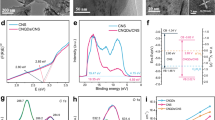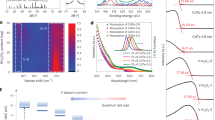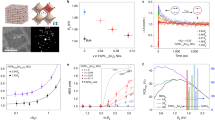Abstract
Multiple exciton generation (MEG) in quantum dots (QDs) has the potential to greatly increase the power conversion efficiency in solar cells and in solar-fuel production. During the MEG process, two electron–hole pairs (excitons) are created from the absorption of one high-energy photon, bypassing hot-carrier cooling via phonon emission. Here we demonstrate that extra carriers produced via MEG can be used to drive a chemical reaction with quantum efficiency above 100%. We developed a lead sulfide (PbS) QD photoelectrochemical cell that is able to drive hydrogen evolution from aqueous Na2S solution with a peak external quantum efficiency exceeding 100%. QD photoelectrodes that were measured all demonstrated MEG when the incident photon energy was larger than 2.7 times the bandgap energy. Our results demonstrate a new direction in exploring high-efficiency approaches to solar fuels.
This is a preview of subscription content, access via your institution
Access options
Access Nature and 54 other Nature Portfolio journals
Get Nature+, our best-value online-access subscription
$29.99 / 30 days
cancel any time
Subscribe to this journal
Receive 12 digital issues and online access to articles
$119.00 per year
only $9.92 per issue
Buy this article
- Purchase on Springer Link
- Instant access to full article PDF
Prices may be subject to local taxes which are calculated during checkout




Similar content being viewed by others
References
Lewis, N. S. Research opportunities to advance solar energy utilization. Science 351, aad1920 (2016).
Turner, J. A. Sustainable hydrogen production. Science 305, 972–974 (2004).
Ross, R. T. & Nozik, A. J. Efficiency of hot-carrier solar energy converters. J. Appl. Phys. 53, 3813–3818 (1982).
Klimov, V. I. Multicarrier interactions in semiconductor nanocrystals in relation to the phenomena of Auger recombination and carrier multiplication. Annu. Rev. Condens. Matter Phys. 5, 285–316 (2014).
Sambur, J. B., Novet, T. & Parkinson, B. A. Multiple exciton collection in a sensitized photovoltaic system. Science 330, 63–66 (2010).
Semonin, O. E. et al. Peak external photocurrent quantum efficiency exceeding 100% via MEG in a quantum dot solar cell. Science 334, 1530–1533 (2011).
Davis, N. J. L. K. et al. Multiple-exciton generation in lead selenide nanorod solar cells with external quantum efficiencies exceeding 120%. Nat. Commun. 6, 8259 (2015).
Böhm, M. L. et al. Lead telluride quantum dot solar cells displaying external quantum efficiencies exceeding 120%. Nano Lett. 15, 7987–7993 (2015).
Han, Z., Qiu, F., Eisenberg, R., Holland, P. L. & Krauss, T. D. Robust photogeneration of H2 in water using semiconductor nanocrystals and a nickel catalyst. Science 338, 1321–1324 (2012).
Seol, M., Jang, J.-W., Cho, S., Lee, J. S. & Yong, K. Highly efficient and stable cadmium chalcogenide quantum dot/ZnO nanowires for photoelectrochemical hydrogen generation. Chem. Mater. 25, 184–189 (2012).
Kim, H., Seol, M., Lee, J. & Yong, K. Highly efficient photoelectrochemical hydrogen generation using hierarchical ZnO/WOx nanowires cosensitized with CdSe/CdS. J. Phys. Chem. C 115, 25429–25436 (2011).
Trevisan, R. et al. Harnessing infrared photons for photoelectrochemical hydrogen generation. A PbS quantum dot based “quasi-artificial leaf”. J. Phys. Chem. Lett. 4, 141–146 (2012).
Yan, H. et al. Visible-light-driven hydrogen production with extremely high quantum efficiency on Pt–PdS/CdS photocatalyst. J. Catalys. 266, 165–168 (2009).
Lai, L.-H., Gomulya, W., Protesescu, L., Kovalenko, M. V. & Loi, M. A. High performance photoelectrochemical hydrogen generation and solar cells with a double type II heterojunction. Phys. Chem. Chem. Phys. 16, 7531–7537 (2014).
Ma, G. et al. Direct splitting of H2S into H2 and S on CdS-based photocatalyst under visible light irradiation. J. Catalys. 260, 134–140 (2008).
Crisp, R. W. et al. Metal halide solid-state surface treatment for high efficiency PbS and PbSe QD solar cells. Sci. Rep. 5, 9945 (2015).
Zhang, J. et al. Preparation of Cd/Pb chalcogenide heterostructured janus particles via controllable cation exchange. ACS Nano. 9, 8157–8164 (2015).
Stewart, J. T. et al. Comparison of carrier multiplication yields in PbS and PbSe nanocrystals: the role of competing energy-loss processes. Nano Lett. 12, 622–628 (2012).
Shockley, W. & Queisser, H. J. Detailed balance limit of efficiency of p–n junction solar cells. J. Appl. Phys. 32, 510–519 (1961).
Hanna, M. C. & Nozik, A. J. Solar conversion efficiency of photovoltaic and photoelectrolysis cells with carrier multiplication absorbers. J. Appl. Phys. 100, 074510 (2006).
Khaselev, O. & Turner, J. A. A monolithic photovoltaic-photoelectrochemical device for hydrogen production via water splitting. Science 280, 425–427 (1998).
Gu, J. et al. p-Type CuRhO2 as a self-healing photoelectrode for water reduction under visible light. J. Am. Chem. Soc. 136, 830–833 (2014).
Gu, J. et al. Water reduction by a p-GaInP2 photoelectrode stabilized by an amorphous TiO2 coating and a molecular cobalt catalyst. Nat. Mater. 15, 456–460 (2015).
White, J. L. et al. Light-driven heterogeneous reduction of carbon dioxide: photocatalysts and photoelectrodes. Chem. Rev. 115, 12888–12935 (2015).
Cirloganu, C. M. et al. Enhanced carrier multiplication in engineered quasi-type-II quantum dots. Nat. Commun. 5, 4148 (2014).
Chernomordik, B. D., Marshall, A. R., Pach, G. F., Luther, J. M. & Beard, M. C. Quantum dot solar cell fabrication protocols. Chem. Mater. 29, 189–198 (2017).
Gu, J. et al. A graded catalytic-protective layer for an efficient and stable water-splitting photocathode. Nat. Energy 2, 16192 (2017).
Acknowledgements
We would like to thank B. To and C. Xiao from NREL for the scanning electron micrographs. A. J. Nozik, J. Luther, D. Kroupa and Y. Yang are thanked for their helpful discussions. Y.Y. would like to acknowledge the support from the startup fund at New Jersey Institute of Technology. Y.Y., R.W.C., B.D.C., G.F.P., A.R.M. and M.C.B. acknowledge support from the Center for Advanced Solar Photophysics, an Energy Frontier Research Center funded by the Office of Basic Energy Sciences within the Office of Science. J.G. and J.A.T. acknowledge the solar photochemistry programme within the division of Chemical Sciences,Geosciences, and Biosciences of the Office of Basic Energy Sciences within the Office of Science. All work is supported by the Department of Energy under contract No. DE-AC36-08GO28308 to NREL.
Author information
Authors and Affiliations
Contributions
Y.Y. and M.C.B. conceived the experiments and led the project; Y.Y. and J.G. carried out the photoelectrode synthesis and characterization and photoelectrochemical investigation; R.W.C., B.D.C., G.F.P. and A.R.M. carried out quantum-dot synthesis and film preparation; Y.Y., J.A.T. and M.C.B. analysed the data; Y.Y. and M.C.B. wrote the manuscript with input and discussion from all authors.
Corresponding authors
Ethics declarations
Competing interests
The authors declare no competing financial interests.
Supplementary information
Supplementary Information
Supplementary Figures 1–3, Supplementary Tables 1–3, Supplementary Note 1 (PDF 933 kb)
Rights and permissions
About this article
Cite this article
Yan, Y., Crisp, R., Gu, J. et al. Multiple exciton generation for photoelectrochemical hydrogen evolution reactions with quantum yields exceeding 100%. Nat Energy 2, 17052 (2017). https://doi.org/10.1038/nenergy.2017.52
Received:
Accepted:
Published:
DOI: https://doi.org/10.1038/nenergy.2017.52
This article is cited by
-
Constructing type-II CuInSe2/CuInS2 core/shell quantum dots for high-performance photoelectrochemical cells
Science China Materials (2024)
-
Spin-exchange carrier multiplication in manganese-doped colloidal quantum dots
Nature Materials (2023)
-
Internal quantum efficiency higher than 100% achieved by combining doping and quantum effects for photocatalytic overall water splitting
Nature Energy (2023)
-
How to get high-efficiency lead chalcogenide quantum dot solar cells?
Science China Physics, Mechanics & Astronomy (2023)
-
Pb-additive Se-Te-In nano-chalcogenide thin films: preparation, morphological, optical analysis and material perspective for phase-change memory devices
Journal of Materials Science: Materials in Electronics (2023)



